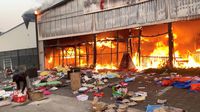
South Africans have seen widespread violence over the past few weeks, with terrible scenes of looted shops, malls, and damaged infrastructure.
For many younger South Africans these scenes may well be unprecedented but violence and unrest in this country is nothing new.
Our country’s history is stained with blood, with clashes ranging from the Frontier Wars in what is today the Eastern Cape, conflicts between Dutch settlers and the Khoisan, the Mfecane, and the various wars between the British and Boers, to name but a few.
And as anyone with even a passing knowledge of South Africa’s history knows violence has not been uncommon since South Africa became united in 1910. Here are three violent episodes from South Africa’s history.
The Rand Revolt was an uprising by white mine workers in what is today Gauteng. The uprising began as a result of a strike at the end of 1921 by white mine workers who were concerned about their wages and job security. Following the end of World War I in 1918 the world entered into a global economic slump. This led to a drop in the gold price which then resulted in mining companies looking to reduce wages.
In South Africa they attempted to weaken the ‘colour bar,’ which reserved semi-skilled and skilled labour (and higher wages) for white people. This was met with anger by white workers leading to a series of strikes. By March 1922 the strikes had evolved into open battles between miners and the police, with the strikers seizing control of a number of towns on the East Rand.
Finally in an attempt to quell the rebellion the army was called in, with support from the embryonic air force. The revolt was finally declared over on 18 March.
Over 200 people were killed in the violence and 1 000 were injured.
The result of the violence led to Prime Minister Jan Smuts losing the 1924 election to a coalition of the National and Labour parties. In addition, in an attempt to placate white miners race-based legislation, which laid the foundation for apartheid in 1948, was passed.
In 1949 there were clashes between black and Indian South Africans in Durban. The violence lasted for three days and left 142 people dead and over 1 000 injured. Infrastructure was also destroyed and 40 000 Indian South Africans were reduced to being refugees in their own country, as they fled the violence.
The clashes began on a Thursday, 13 January, and saw Zulus in Durban attack property owned by Indians. The violence carried on into the Friday, and was finally quelled by the police the following day.
As with many such incidents there does not seem to have been one singular cause of the violence. Contemporary sources of the time note that some of it may have come from economic resentment towards Indians who were (relatively speaking) better off than black South Africans.
‘There is no security for him (black South Africans); there is no future for his children, and there is no outlet for his energies and emotions. He is frustrated and thwarted. His whole life is one long unending queue of disabilities. He has nothing worthwhile enjoying or living for…’ said a contemporary account.
In addition, the rioters were egged on by agent provocateurs. At the time it was reported that the attacks on Indian South Africans were also encouraged by white South Africans.
Despite these terrible events, which was split on race lines, black and Indian South Africans worked together to fight against apartheid. And despite current efforts to turn the unrest in KwaZulu-Natal into a race issue it has been clear that ordinary South Africans of all races have stood together to protect their property and that of their neighbours.
The 1976 Soweto uprising began as a response by schoolchildren to being forced to learn in Afrikaans.
Although 16 June is remembered as the day of the Soweto uprising it actually began on 30 April when children at Orlando West Junior School refused to go to school, in protest at being taught in Afrikaans. The strike soon spread to other schools and on 13 June 1976 it was decided to hold a mass rally three days later – on 16 June.
On 16 June a crowd of between 3 000 and 10 000 Soweto schoolchildren had gathered and began a march through the township. They soon found their way blocked by the police who fired on the children, using live ammunition. One of the first victims was Hector Pietersen, the image of him being carried, bleeding out of his mouth, by Mbuyisa Makhubo, soon became a symbol of the brutality of the apartheid state.
The shooting saw a pushback from Soweto residents, with infrastructure that was seen as symbolic of apartheid was attacked. By the next day heavily armed police had restored order.
Estimates of the number people killed range from 23 (the official number recorded by the apartheid government) to 700. Most historians agree that the true number is about 176.
However, the unrest spread to other parts of the country and some analysts believe that the actions of the students in Soweto heralded the beginning of the end of the apartheid state.
The current unrest we are seeing is not new. And the truth is that if we had to discuss every single major incident of violence in South Africa since 1910 you could probably write a book.
Nevertheless, often major episodes of violence (such as the Rand Revolt and the Soweto Uprising) resulted in significant political change later on. It is quite likely that the current unrest we are witnessing will result in the same.
